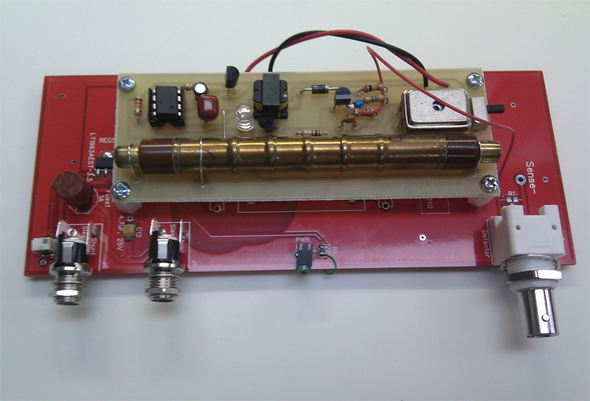Sect. 7, Construction of ERGO’s Pixels
Any electronic imaging systems consists of a collection of individual image detecting units, usually called “pixels.” Signals from all the pixels are combined to generate an image. Working like a common digital camera, ERGO consists of an array of individual sensitive elements, or pixels. Each “pixel” consists of a Muon Detector, a Timestamp Generator, and an embedded Ethernet server that provides the internet connection.
Even though the pixels will be spread unevenly over Earth’s surface, we will be able to synthesize an image by using the geographic location information reported in each timestamp. In fact, even if one of the pixels is moving, we can include its observations into the overall database by allowing for its changing position. We can imagine “moving pixels” in aircraft, on ships, and with explorers in hard-to-reach areas of Earth. Since most of Earth isn’t covered by land, the use of temporary and moving locations will be essential to provide coverage of the full extent of the planet.
![]()
Each pixel of the ERGO imaging array consists of these elements:
- Muon Detectors: When cosmic ray particles (usually protons) hit the upper atmosphere, a large shower of particles travels down to Earth’s surface at nearly the speed of light. The majority of particles that reach the surface are muons, high-energy charged particles that are easy to detect. The simplest muon detector is a Geiger counter, and the Beta detector units are based upon simple Geiger-Müller (G-M) detector tubes excited by several hundred volts of electrical charge. When a charged particle, such as a cosmic-ray-generated muon, passes through the G-M tube, a small spark occurs, generating an electrical signal that goes to the Timestamp Generator.
Geiger-Müller Muon Detector
Also being developed for ERGO are glass “resistive plate chamber” (RPC) detectors, which are larger and sensitive only to high-energy particles. RPC detectors operate at much higher voltage and are not commercially available, so the ERGO project is hoping to develop a suitable detector for its use. These detectors will detect fewer counts of Earth-based background radiation (such as those resulting from radon in the air) and their larger area will increase the likelihood of detecting the cosmic-ray muons of interest.
- Timestamp Generators: The essence of a distributed telescope system is coordinating the observations of many observation sites. Cosmic ray events are detected at each site, and a data packet containing the location and precise time of the event is uploaded to the central database server. These data packets are called “timestamps.”
- GPS Receiver: In order to provide high resolution in position and time, each Timestamp Generator contains a GPS receiver that determines the unit’s location and provides a very precise time reference from the GPS satellite system.
- Timestamp Generator Logic: In order to produce a timestamp data packet, including the local latitude, longitude, altitude, date, time, and fractions of second when the event was detected, a circuit consisting of logic circuits and microprocessors manipulates the signals and data to produce the data packet. By using a crystal oscillator to divide seconds into a billion parts (nanoseconds), the logic produces timestamps precise to within a few meters of position and to within a few tenths of a microsecond of true “GPS time.”
- Internet Connection: Once an event is detected and a timestamp generated, a miniature Ethernet server within the Timestamp Generator uploads the timestamp to the central database server by way of an cable connected to the LAN at the site where the system is located. The only outside resources that the participating organizations need to supply are power and a LAN connection with internet connectivity.

